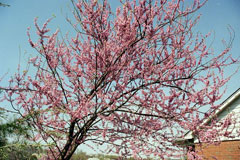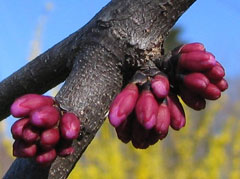 |
|
http://www.flickr.com/people/47398215@N00 |
 |
| http://commons.wikimedia.org/wiki/User:Phyzome |
Translate this page:
Summary
Bloom Color: Lavender, Pink, Purple.Main Bloom Time: Early spring, Late spring, Mid spring. Form: Rounded, Vase.
Physical Characteristics

 Cercis canadensis is a deciduous Tree growing to 12 m (39ft) by 10 m (32ft) at a medium rate.
Cercis canadensis is a deciduous Tree growing to 12 m (39ft) by 10 m (32ft) at a medium rate.
See above for USDA hardiness. It is hardy to UK zone 4 and is not frost tender. It is in flower from May to June, and the seeds ripen in October. The species is hermaphrodite (has both male and female organs) and is pollinated by Bees.
It is noted for attracting wildlife.
Suitable for: light (sandy) and medium (loamy) soils and prefers well-drained soil. Suitable pH: mildly acid, neutral and basic (mildly alkaline) soils and can grow in very acid and very alkaline soils.
It can grow in semi-shade (light woodland) or no shade. It prefers moist soil.
UK Hardiness Map
US Hardiness Map
Synonyms
Plant Habitats
Woodland Garden Secondary; Sunny Edge; Dappled Shade;
Edible Uses
Edible Parts: Flowers Leaves Seedpod
Edible Uses: Condiment
Flowers - raw[46, 61, 94, 183] or pickled[2, 105, 149]. A nice refreshing acid taste, the flowers are rich in vitamin C and make a pleasant addition to salads[183, K]. They can also be used as a condiment[200]. The unopened buds are pickled or used as a caper substitute[183]. On a zero moisture basis, the seed contains 22.9 - 27.5% protein, 7.7 - 8.8% fat and 3% ash[218]. (This report does not say if the seed is edible[K]). There is some evidence that both the young seed pods (eaten like snow peas) and the young leaves
can be eaten.
References More on Edible Uses
Medicinal Uses
Plants For A Future can not take any responsibility for any adverse effects from the use of plants. Always seek advice from a professional before using a plant medicinally.
Astringent Cancer Dysentery Febrifuge Pectoral Vitamin C
A tea made from the inner bark is highly astringent[46, 61, 94, 149, 222]. Used in the treatment of fevers, diarrhoea and dysentery, it is also a folk remedy for leukaemia[222]. A cold infusion of the roots and inner bark have been used to treat various chest complaints including whooping cough and congestion[257].
References More on Medicinal Uses
The Bookshop: Edible Plant Books
Our Latest books on Perennial Plants For Food Forests and Permaculture Gardens in paperback or digital formats.

Edible Tropical Plants
Food Forest Plants for Hotter Conditions: 250+ Plants For Tropical Food Forests & Permaculture Gardens.
More

Edible Temperate Plants
Plants for Your Food Forest: 500 Plants for Temperate Food Forests & Permaculture Gardens.
More

More Books
PFAF have eight books available in paperback and digital formats. Browse the shop for more information.
Shop Now
Other Uses
Basketry Wood
The bark of young shoots is used in basket making[94, 106]. Wood - heavy, hard, not strong, close grained, takes a very fine polish[82, 94]. It weighs 40lb per cubic foot[235].
Special Uses
Attracts Wildlife Food Forest
References More on Other Uses
Cultivation details
Landscape Uses:Border, Standard, Specimen, Street tree, Woodland garden. Succeeds in most soils and pH types, but dislikes growing in wet soils, especially when these are of clay[200]. Prefers a deep sandy loam and a very sunny position[11, 98, 182]. Succeeds in light shade[200]. Dislikes drought[200]. Although the dormant plant is cold-hardy, the young growth in spring, even on mature plants, is frost-tender and so it is best to grow the plants in a position sheltered from the early morning sun[K]. A fast-growing but short-lived tree in the wild[229]. It does not flower freely in Britain[188]. There is at least one named form, selected for its ornamental value[188]. This spcies is the state tree of Oklahoma[274]. The flowers are produced on the branches of the previous or earlier years, and also on the trunk of the plant[82]. Plants are susceptible to coral spot fungus, especially when growing in areas with cooler summers where the wood is not fully ripened[11]. Plants in this genus are notably resistant to honey fungus[200]. A good bee plant[149]. Resents root disturbance, plants should be planted into their permanent positions as soon as possible, preferably in May, and should be kept well watered until established[11, 188]. This species is one of the few members of the family Leguminosae that do not fix atmospheric nitrogen[226]. Special Features:North American native, Attracts butterflies, Blooms are very showy. The plant is heat tolerant in zones 9 through 2. (Plant Hardiness Zones show how well plants withstand cold winter temperatures.
Plant Heat Zones show when plants would start suffering from the heat.
The Plant Heat Zone map is based on the number of "heat days" experienced in a given area where the temperature climbs to over 86 degrees F (30°C).
At this temperature, many plants begin to suffer physiological damage. Heat Zones range from 1 (no heat days) to 12 (210 or more heat days).
For example Heat Zone. 11-1 indicates that the plant is heat tolerant in zones 11 through 1.) For polyculture design as well as the above-ground architecture (form - tree, shrub etc. and size shown above) information on the habit and root pattern is also useful and given here if available. The plant growth habit is a standard with a non-suckering single trunk [1-2]. The root pattern is a tap root similar to a carrot going directly down [1-2].
References Carbon Farming Information and Carbon Sequestration Information
Temperature Converter
Type a value in the Celsius field to convert the value to Fahrenheit:
Fahrenheit:
The PFAF Bookshop
Plants For A Future have a number of books available in paperback and digital form. Book titles include Edible Plants, Edible Perennials, Edible Trees,Edible Shrubs, Woodland Gardening, and Temperate Food Forest Plants. Our new book is Food Forest Plants For Hotter Conditions (Tropical and Sub-Tropical).
Shop Now
Plant Propagation
Seed - best sown as soon as it is ripe in a cold frame[200]. Pre-soak stored seed for 24 hours in warm water then cold stratify for 3 months[113]. Sow spring in the greenhouse[78]. As soon as they are large enough to handle, prick the seedlings out into individual pots and grow them on in a greenhouse for their first winter. Plant them out into their permanent positions in late spring or early summer, after the last expected frosts. Plants resent root disturbance and are best planted out in their permanent positions as soon as possible[11]. Cuttings of half-ripe wood, July/August in a frame[200].
Other Names
If available other names are mentioned here
Native Range
NORTHERN AMERICA: United States, Indiana, Michigan (south), New Jersey, Ohio, Pennsylvania, West Virginia, Illinois, Iowa, Kansas, Missouri, Nebraska (east), Oklahoma, Alabama, Arkansas, Delaware, Florida, Georgia, Kentucky, Louisiana, Maryland, Mississippi, North Carolina, South Carolina, Tennessee, Virginia, New Mexico (southeast), Texas, Mexico, Chihuahua (east), Coahuila de Zaragoza, Nuevo León, San Luis Potosí, Tamaulipas, Hidalgo, Puebla, Querétaro, Veracruz de Ignacio de la Llave,
Weed Potential
Right plant wrong place. We are currently updating this section.
Please note that a plant may be invasive in one area but may not in your area so it’s worth checking.
Conservation Status
IUCN Red List of Threatened Plants Status :

Growth: S = slow M = medium F = fast. Soil: L = light (sandy) M = medium H = heavy (clay). pH: A = acid N = neutral B = basic (alkaline). Shade: F = full shade S = semi-shade N = no shade. Moisture: D = dry M = Moist We = wet Wa = water.
Expert comment
Author
L.
Botanical References
1143200
Links / References
For a list of references used on this page please go here
Readers comment
All the information contained in these pages is
Copyright (C) Plants For A Future, 1996-2012.
Plants For A Future is a charitable company limited by guarantee, registered in England and Wales. Charity No. 1057719, Company No. 3204567,
Web Design & Management
This work is licensed under a Creative Commons License. Some information cannot be used for commercial reasons or be modified (but some can). Please view the
copyright link for more information.